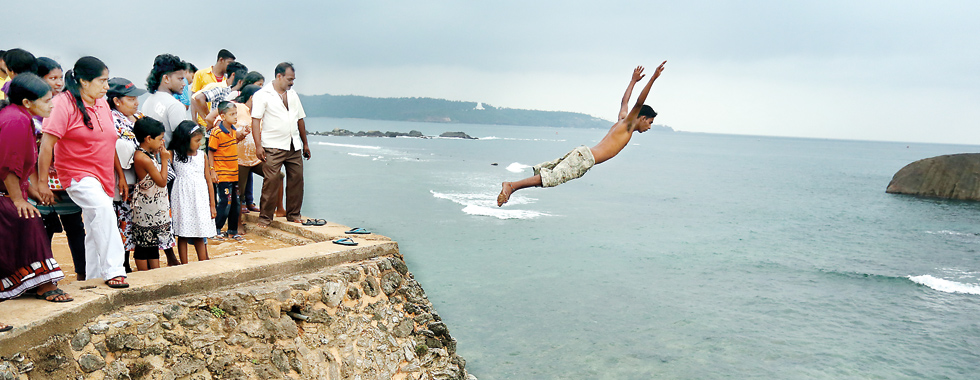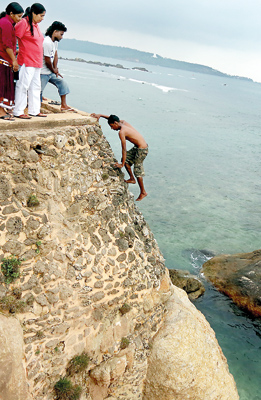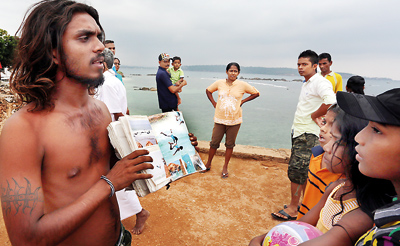Living on the edge
A run, a jump and a splash amidst the cruel rocks, with faces peering down anxiously from far above and spontaneous shouts and loud applause. The act though is not over — more jumps from rocks lower down and then a climb back to the top using the jagged rocks, monkey-style.

Suspended in mid-air: Watched by an anxious crowd, a cliff-jumper makes the leap . Pix by M.A. Pushpa Kumara
Bare-chested and clad in long-shorts, a cliff-jumper of the Galle Fort has just concluded a stunning and dangerous performance, to many an encore. However as the New Year dawns, these innovative Galle Fort cliff-jumpers, only a handful now, are a disgruntled lot.
“We won’t be able to do these stunts for long,” says 27-year-old M.K. Buddhika who points out that many of the pioneers of these dangerous dives way back in 1988 have gone abroad in search of greener pastures.
There are only six of us and we have no future, he laments, adding that the authorities should look into their “skill” and provide other opportunities for them. For 10 years Buddhika had practised from “yata gal walin” (rocks lower down) before attempting the 16-metre (more than 35 ft) jump from the ramparts of the Galle Fort close to the lighthouse.
Now he’s not afraid, but as a youngster who was tempted to take to this slippery slope when he came for sea baths, as he was living near the Mahajana Pola in Galle at that time, the self-learning was not only arduous but also injury-prone. This trajectory was his only hope of earning a living.

And up again: Climbing up the ramparts after the jump
Kiyanna beri then wala thuwala wela thiyenwa, says Buddhika sheepishly, explaining that he has suffered injury in places he cannot mention. While we chat and the skies darken with a strong hint of rain, the cliff-jumpers are becoming desperate. They have not had much business for the whole day (December 17) and when they attempt to get a few foreigners interested in their art by showing them a bulging photograph album, they smile and walk away after clicking the beautiful coastline and horizon off Galle from the vantage point of the ramparts.
One foreign woman carrying a baby calls them “you crazy fools”, for which the quick repartee is: “We are professional jumpers. Sri Lankan people can do this, it’s our talent.” Then these young men who are living dangerously turn their attention to the locals, who have walked up in twos and threes to take in the view………bringing their price down to Rs. 50 per family where earlier they were asking the foreigners for US$20.
If we don’t jump, and we do it in turns, who will feed our families, asks Buddhika, adding that two of the six cliff-jumpers are married and have little children as well. By this time, the cliff-jumpers have drummed up adequate support from the locals, with inquisitive women in some families egging on their spouses to fork out the money and little children pulling at their fathers’ hands to take them close to the sharp drop.
Suddenly, there is pin-drop silence and an air of expectancy, with only the murmur of the wind blowing in from the Indian Ocean. The crowd is requested to part, leaving the cliff-jumper’s pathway to the edge, free of obstruction. It is scrawny Angulugaha Sanjeewa’s turn. Clad in camouflage long-shorts, he makes a mock run to the edge of the cliff, stops short and then gently removes his sky-blue slippers on the rock.
A bow towards the majestic but glowering sea, a kind of ritual, and he backs up again. Next moment, a flashing-glimpse of a runner and he has taken off. He soars spread-eagled like a bird in flight and within seconds hits the water head first, close to the rocks, with a splash.
Stunned silence amidst the “all-eyes” crowd but when Sanjeewa surfaces, bated breath is let out in audible sighs of relief. A few more somersaults into the narrow sea passage between the rocks once again from a few rocks at a lower height and applause bursts out from the crowd.

See what we can do: A cliff-jumper shows their album of photographs
The rain begins to pelt down and the people pay up their Rs. 50 and run for shelter. That day’s ‘work’ is over for the cliff-jumpers though it is only about 3.30 in the afternoon. Although they come to their ‘post’ atop the cliffs as early as 6 a.m. and stay on till 6 p.m. when dusk drops like a mantle on the Galle Fort making it impossible for them to make that jump, sometimes there is no business the whole day.
“We have no other options, as jobs are hard to come by. But this is not something we can do forever, because as we grow older our bodies become weak,” reiterates Buddhika, pleading with the government to give them some support in the New Year.
Yes, a slight miscalculation and a cliff-jumper, sans safety-net or safety-line, could hit the rocks and be shattered to pieces.
The Galle Fort cliff-jumpers are, in reality, between the deep blue sea and a very hard place, from which there seems no way out.


